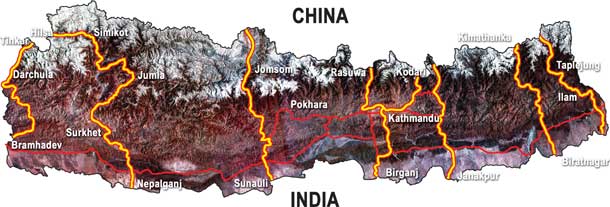 Ever since King Gyanendra proposed Nepal as a transit for India-China trade after Jakarta's Afro-Asian Summit in March there has been renewed interest in north-south trans-Himalayan highways.
Ever since King Gyanendra proposed Nepal as a transit for India-China trade after Jakarta's Afro-Asian Summit in March there has been renewed interest in north-south trans-Himalayan highways.
But there are also doubts about whether our giant neighbours actually need such a link, and more importantly, if Nepal would really benefit.
Bilateral trade between India and China reached $ 13 billion last year and is expected to double in five years. India is emerging as an exporter of foodgrains and China is a nett importer. Lhasa will be connected to China's industrial heartland by a railroad to be completed in 2007. Nepal could take advantage of its strategic location to offer transit facilities and benefit from trade and taxes.
At present only the 400-km Birganj-Kathmandu-Kodari serves as a highway link between India and China but there is no through-traffic. There are possibilities of developing other north-south routes, of which the 265-km Birganj-Kathmandu-Rasuwa could be completed the quickest. But there are seven other routes, most of which follow north-south Himalayan rivers and could shorten the distance between Tibet and northern India.
The Chinese are currently helping build a 22 km section between Syabru and the border. When the Galchhi-Trisuli section of the road is finished in two years, it will effectively open the Birganj-Trisuli-Rasuwa link. "This will be the fastest, most efficient road corridor connecting Nepal's northern and southern borders at present," says Durga Prasad KC, director general of the Department of Roads.
However, the ancient trade route between India and Tibet through Nathu La in Sikkim is due to open for crossborder traffic next month and would be the shortest distance between Lhasa and Calcutta. The Chinese are completing a highway from Lhasa to Nathu La to connect to India and are unlikely to go for another road through Nepal at present.
A Kathmandu-based Chinese expert told us: "China will opt for the Nepal transit only if it is cheaper, but a feasibility needs to be done first and find if there is real benefit for Nepal."
However, Nathu La is far from India's manufacturing belt and a Nepal link could be shorter. At 3,500 m Nathu La is also snowbound for four months in a year and the serpentine highway needs to be widened to take multi-axle container trucks.
Nepal's proposed Kosi Highway from Rani-Kimathanka could be a faster all-weather road link between India and China with an easier gradient. The other attractive north-south highway is the Sunauli-Kusma-Jomsom-Lo Manthang route of which an 18 km section from Korala to Lo Manthang is already complete and there are sections along the Kali Gandaki that are under construction.  But in the final analysis, the feasibility of a road system needs to take into account the level of future trade between Tibet and India (which at present is negligible) as well as the comparative cost with sea transport.
But in the final analysis, the feasibility of a road system needs to take into account the level of future trade between Tibet and India (which at present is negligible) as well as the comparative cost with sea transport.
"The challenge is to design a transit service that can compete with sea transport on cost so that it is attractive and efficient to promote bilateral trade between India and China," says Kamal Raj Pande, at DoR's Planning and Design Section which is trying to look at optimal routes that would also promote domestic integration.
Indeed, Nepali planners have to look at whether it is better to invest scarce resources in building highway links that serve domestic priorities. One such link would be the fast-track from Hetauda to Kathmandu which would save billions of rupees a year on fuel alone.
Some experts doubt that a China-India land trade route through Nepal is feasible at present. Tibet is sparsely populated and China's industrial heartland is on its eastern seaboard, 5,000 km away by train from Tibet. "Even if India and China were to find it feasible, the big question is whether Nepal would benefit from being a transit point," says one senior Nepali official, "we need to build north-south highways for our sake and according to our own priorities, not for India-China trade."
It is clear that not enough homework has been done. India had formally conveyed its interest on transit rights through Nepal for its China trade at an inter-governmental meeting in Kathmandu in 2004. But Nepal hasn't officially responded, and the subject hasn't cropped up in India-China bilateral meetings. China agreed to developing Nepal transit highways during recent bilateral economic and trade talks in Beijing.
"The benefits to Nepal needs to be thought through," says British highway consultant John Howell, "otherwise there is a risk that environmental damage from pollution and even HIV/AIDS incidence along transport corridors will outweigh the benefits." Indeed, the Swiss have now stopped container trucks from trans-Alpine corridors between Germany and Italy. All containers must ride trains.
Although in the short-term it is hard to see big benefits from India-China trade for Nepal, transit highways could ultimately bring payback from taxes, trans-shipment services, jobs, fuel stations, better north-south connectivity and also stimulate investments in hydropower and decentralise Nepal's development.
For now, though, Nepal may have to consider its own immediate domestic infrastructure priorities. One India-Nepal trade expert quipped: "There is the terrifying thought of Punjabi drivers pushing underpowered and overaged Tata trucks groaning and belching black smoke past Dhunche towards the Tibetan
plateau."
In Transit
1 Birganj-Naubise-Kathmandu-Dolalghat-Kodari 393km
2 Birganj-Patlaiya-Fast Track Kathmandu-Kodari 292km
3 Birganj-Patlaiya-Trisuli-Rasuwa 265km
4 Sunauli-Mirmi-Kusma-Jomsom-Korala 467km
5 Rani-Hile-Tumlingtar-Kimathanka 419km
6 Janakpur-Dolakha-Lamabagar 295km
7 Nepalganj-Surkhet-Jumla-Simikot-Hilsa 436km
8 Kechana-ilam-Phidim-Taplejung-Olangchungola 460km
9 Brahmadeb-Jogbuda-Darchula-Tinkar 415km


